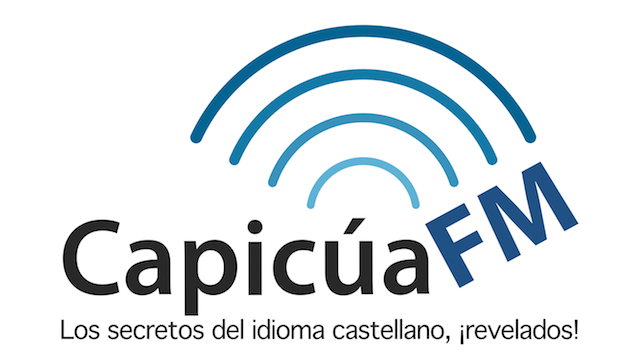
ProVideo Coalition readers who are interested in audio production will recall my recent article about Bossjock Studio, and my review of the AT-MX351a automatic audio mixer which kills crosstalk (links ahead). Well now I recorded and published my first “live-to-drive” podcast, as opposed to post-producing everything later, as I did in the past. I also used the iRig Pro A-to-D converter. Ahead is the setup, and the experience.
Links to recent related articles
- Bossjock Studio creates a “live” radio studio in your iPad/iPhone/iPod Touch (April 20, 2014)
- Cure audio spill in multi-mic situations with an AT-MX351a automatic mixer (May 10, 2014)
What is CapicúaFM ?
CapicúaFM is the name of a Castilian-language audio podcast I recently launched about the most widely used Spanish language, culture, music, food, kids’ games, and occasionally palindromes! In fact, the word capicúa is actually a compound Catalán word that was borrowed by Castilian and duly credited in the dictionary. The three sub-words are cap — i — cúa, which literally mean head — and — tail, i.e. (as with all palindromes, be they numbers, words, or proper names), the head matches the tail.
The first episode includes guest host and invitee Bárbara Intriago, a Chilean singer who has sung in multiple arenas, including Madison Square Garden in New York. Episode 1 was designed both to introduce the program and —of course— to interview Bárbara about her musical career. CapicúaFM is currently available via iTunes, Stitcher Radio and most other premium podcatcher apps including Downcast, Instacast, and PocketCasts, by simply searching for CapicúaFM within them.
The intros, outros, and bumpers in CapicúaFM all include the voices of Víctor Martorella and Victoria Mesas García, and gracefully illustrate the differences in pronunciation between standard Castilian as spoken in the Americas versus in Spain. I wrote the text, and the recordings were mastered by Víctor Martorella of VoiceOverMart. Víctor and Victoria have actually never met, and each of them recorded independently in two separate continents. Víctor magically arranged the “chorus” effect in those moments where they both deliver the same words together.
The setup
For the “live-to drive” setup, we used two AT2005USB hybrid dynamic cardioid microphones using their analog XLR outputs. (I have covered these microphones in multiple articles and ebooks in two languages.) The two microphones were mounted in Heil PL2T flexible booms mounted on a desk.
The two microphones fed the AT-MX351a automatic mixer, which (as explained in my recent review) have the special feature of reducing or eliminating crosstalk or spill between two microphones located in the same room.
The balanced XLR line-level signal fed the iRig Pro which digitized it in order to deliver it to my iPad Mini Retina (128GB). Even though the iRig Pro from IK Multimedia (review coming soon) is both a preamp and A-to-D converter, in this case, it was only used as an A-to-D converter since the signal being fed was already line level, so the input level on the iRig Pro was set to absolute minimum, phantom power was disengaged, and it ran with no battery inside, since when phantom power is not required, it is completely powered by the iOS device. As explained in prior articles, the idea of sending a digital audio signal to the iPad is to bypass the iPad’s own preamp and A-to-D converter.
Bárbara and I both wore isolating stereo headphones which were connected via a Y-cable to the output of the iPad Mini Retina. That way, we were able to hear not only ourselves, but also all of the virtual carts from Bossjock Studio.
Once the iRig Pro is connected, it is very easy to be absolutely sure that Bossjock Studio has “seen” the digital input and is using it since it only shows the option to choose between treating the mic source as Stereo or Dual Mono when it is connected to a digital source, as covered in the original review. Since the iRig Pro is only mono (but feeds the digital signal as Dual Mono), making that change in Bossjock Studio makes no difference in this case. However, the final recording is indeed stereo, so you retain all of the stereo richness of your audio clips, if appropriate, as is the case with CapicúaFM, so all of the microphones are centered in the stereo image in either position when using the iRig Pro.
Prior to the “live-to-drive” recording, I prepared several of Bossjock Studio’s virtual carts with the CapicúaFM intro, outro, commercial spots, bumpers, musical beds, and songs sung my Bárbara Intriago, which I had previously ripped from her CD. While I prepared each virtual cart, I was impressed how with each one, I was able to determine on a cart-by-cart basis which ones would include a fade-up and fade-out, which should use automatic ducking (to suppress its level when the microphones are open), and which are set to auto-loop. These are wonderful details which I applaud from the developers of Bossjock Studio. Since the intro and outro were already created with a fade-in and fade-out, I deactivated auto-fade and looping with them. With the musical beds, I activated both looping and auto-ducking.
As stated in the review, as of the publication date of this article, BossJock Studio is still only capable of recording 44.1 kHz, although the developer has promised that 48 kHz recording support is coming sometime soon, via an upgrade. The upcoming 48 kHz support is key when it is desirable to shoot an accompanying video, since 48 kHz is the absolute standard for digital audio for digital video.
The “live-to-drive” experience
Once the mic levels are properly set on the AT-MX351a automatic mixer and Bossjock Studio is in the record mode, it is really a breeze to operate it, even easier than in a conventional audio studio with physical carts and a physical audio mixer. I would rate the performance of the AT-MX351a automatic mixer at 95%. Perhaps 5% of the time, it was a bit slow to react to an interruption, but even so you still hear the interrupting person, since the inactive mic is never completely off, but just attenuated by 8 dB. I would much prefer to hear a person slightly soft for half a second 5% of the time than to hear spill/crosstalk 100% of the time.
For more information about CapicúaFM, here's the site. I’ll cover encoding and distribution in future articles.
Upcoming articles, reviews, and books
Stand by for upcoming articles, reviews, and books. Sign up to my free mailing list by clicking here.
Si deseas suscribirte a mi lista en castellano, visita aquí. Si prefieres, puedes suscribirte a ambas listas (castellano e inglés).
My latest book (paperback + ebook)
My most recent book is available in two languages, and in paperback as well as an ebook. The ebook format is Kindle, but even if you don’t have a Kindle device, you can read Kindle books on many other devices using a free Kindle app. That includes iPad, Android tablets, Mac computers, and Windows computers. Although generally speaking, Kindle books are readable on smartphones like Androids and iPhones, I don’t recommend it for this particular book since it contains both color photos and color comparison charts. The ebook is also DRM-free.
In English:
In English, it is currently available in the following Amazon stores, depending upon your region:
- Amazon.com, for the US and other countries in the Americas that don’t currently have their own Amazon store, or anywhere if you simply prefer it
- Amazon.br for Brazil
- Amazon.ca for Canada
- Amazon.de for Germany
- Amazon.es for Spain pero a lo mejor lo preferirás en castellano, a continuación)
- Amazon.fr for France
- Amazon.in for India
- Amazon.it for Italy
- Amazon.co.jp for Japan
- Amazon.com.mx for México
- Amazon.co.uk for the United Kingdom
Or in your favorite bookstore by requesting ISBN–10: 1456310232 or ISBN–13: 978–1456310233.
En castellano:
En castellano, está disponible actualmente en las siguientes tiendas Amazon, según tu región:
- Amazon.com para EE.UU. y todas las Américas donde no existe ninguna tienda particular… o en cualquier parte si simplemente lo prefieres
- Amazon.com.br para Brasil
- Amazon.co.jp para Japón
- Amazon.de para Alemania
- Amazon.es para España
- Amazon.fr (Francia)
- Amazon.in para India
- Amazon.it para Italia
- Amazon.com.mx para México
- Amazon.co.uk para el Reino Unido
o en tu librería preferida al solicitar el ISBN–10: 1492783390 ó el ISBN–13: 978–1492783398.
Allan Tépper’s other books, consulting, articles, seminars & audio programs
Contact Allan Tépper for consulting, or find a full listing of his books, articles and upcoming seminars and webinars at AllanTepper.com. Listen to his TecnoTur program, which is now available both in Castilian (aka “Spanish”) and in English, free of charge. Search for TecnoTur in iTunes or visit TecnoTur.us for more information.
FTC disclosure
No manufacturer is specifically paying Allan Tépper or TecnoTur LLC to write this article or the mentioned books. Some of the other manufacturers listed above have contracted Tépper and/or TecnoTur LLC to carry out consulting and/or translations/localizations/transcreations. Many of the manufacturers listed above have sent Allan Tépper review units. So far, none of the manufacturers listed above is/are sponsors of the TecnoTur programs, although they are welcome to do so, and some are, may be (or may have been) sponsors of ProVideo Coalition magazine. Some links to third parties listed in this article and/or on this web page may indirectly benefit TecnoTur LLC via affiliate programs.
Copyright and use of this article
The articles contained in the TecnoTur channel in ProVideo Coalition magazine are copyright Allan Tépper/TecnoTur LLC, except where otherwise attributed. Unauthorized use is prohibited without prior approval, except for short quotes which link back to this page, which are encouraged!


